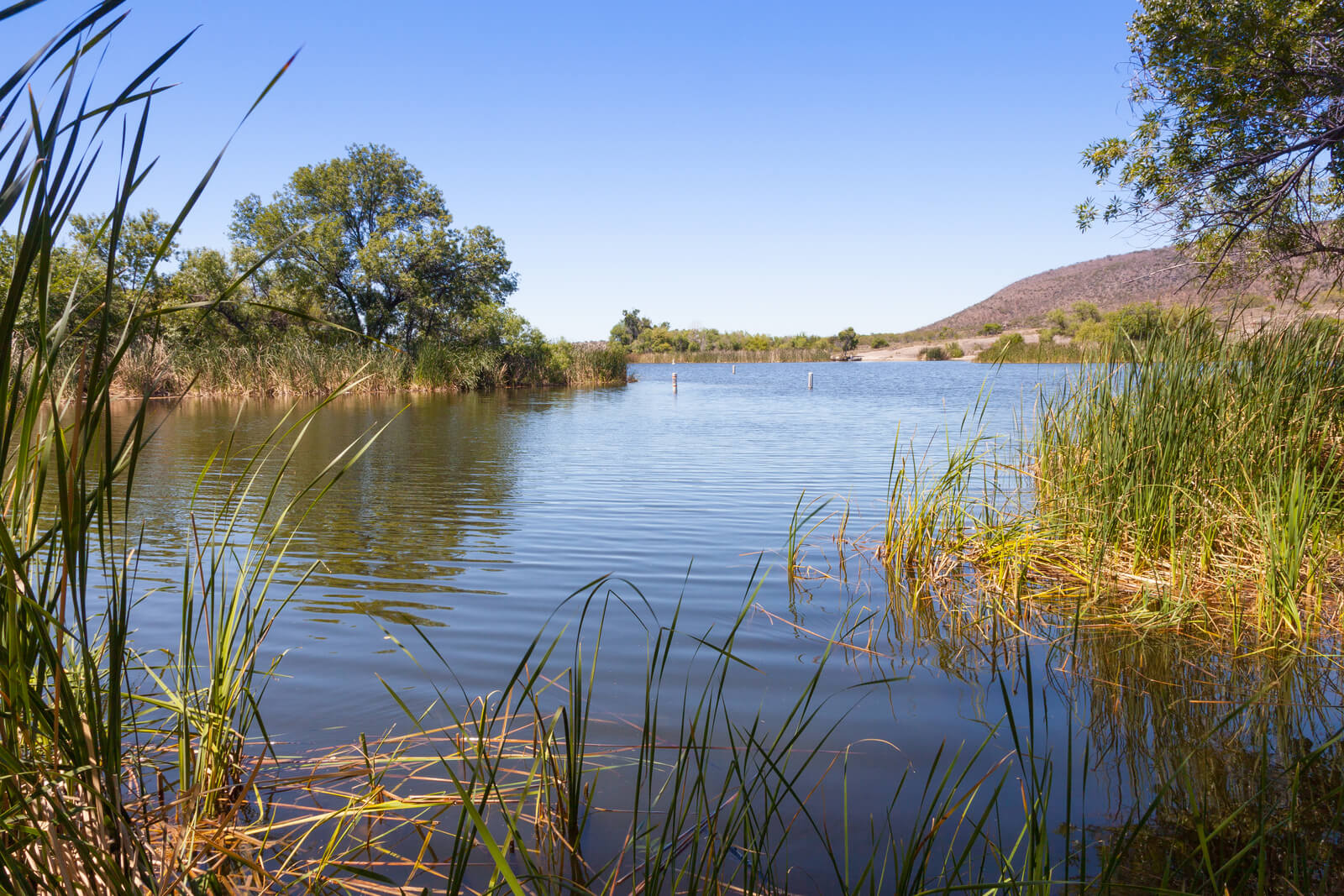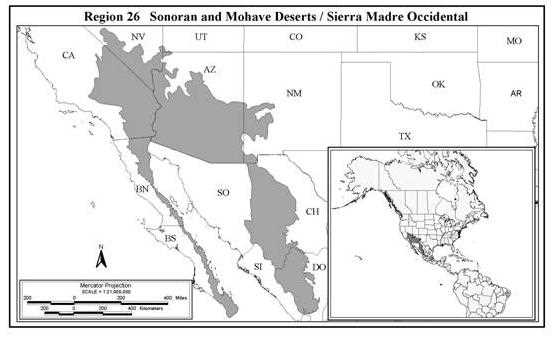Ducks Unlimited conservation priority area, wintering habitat for half the Pacific Flyway ruddy duck population

The most important aquatic habitat in this extremely arid region is the lower Colorado River corridor. Wetlands of the Imperial and Coachella valleys are now dominated by the Salton Sea. A diversion faltered in 1905, causing the Colorado River to flow into the Cahuilla Basin, forming the Salton Sea.
Whitewater Draw Wildlife Area is a significant wetland in the arid Sulphur Springs Valley in Southeastern Arizona. Mystic Lake is the outlet area of the San Jacinto River in California. Once a major ephemeral wetland, the lake was described by Anza in 1774 as "several leagues in circumference and as full of white geese as water." Remnants of Mystic Lake have been protected as part of the San Jacinto Wildlife Area. The national forests of the Mogollon Rim contain more than 17,000 acres of montane wetlands.

Arizona | California | Nevada | New Mexico | Parts of Mexico

The extremely arid Sonoran and Mohave Deserts / Sierra Madre Occidental Region (Region 26*) is marked by few aquatic habitats. The most important is the lower Colorado River corridor. California, Arizona and Nevada now use their full 7.5 million acre-feet apportionment, and little water is available to reach the Sea of Cortez. Although water scarcity was a speculated subject in 1922 when the Colorado River was apportioned for water allocations, it is a reality of the year 2000. However, potential for restoration of floodplain wetlands exists. Several large wetlands (such as the 400 ha Martinez Marsh) exist, but exotic vegetation dominates many of them.
Wetlands of the Imperial and Coachella Valleys are now dominated by the Salton Sea. A diversion faltered in 1905, causing the Colorado River to flow into the Cahuilla Basin, forming the Salton Sea. Waterbirds were quickly attracted to this large water body; however, the shift of the Colorado River back to its original channel and high evapotranspiration resulted in drying of the lakebed. With nowhere to go, drain-water from 4,500 mi2 of intensive farming operations in the Imperial Valley and northern Baja California has been filling the ancient lakebed. Water quality quickly began to decline. Salt content in Salton Sea is 30% more than in the Pacific Ocean. High salt content may be affecting the immune systems of fish causing them to become infected with deadly toxins and in turn passing on these contaminants to fish-eating birds. More than 200,000 eared grebes have died from disease outbreaks since 1992.
Avian botulism at the Salton Sea has claimed more than 27,000 birds, many of them white or California brown pelicans. The disease outbreaks are of concern for the large number of migrant waterbirds that winter on the Sea. Some 110,000 ducks and 25,000 geese (principally lesser snow and Ross') winter at Salton Sea. This is an extremely important wintering site for ruddy ducks and eared grebes. Shallow bays and mud flats attract more than 25 shorebird species, with peak numbers at 125,000 individuals, including western sandpipers, dowitchers, black-necked stilts, and American avocets. More than a third of the known breeding population of western species of gull-billed terns nest at Salton Sea. The 400 Yuma clapper rails represent 40% of the entire United States population. In addition to high salts and selenium, the New River (considered to be the most polluted waterway in the nation) flows into the Salton Sea from Mexico. The river's flow consists mainly of partially treated and raw sewage, agricultural drain water, pesticides, power plant effluent, detergents, and other industrial wastes. Specifically DDT and toxaphene has been identified in the water. Several alternatives to preserve the wildlife habitat values of the Salton Sea are now being considered.
Montane wetlands of the Southwest occur principally at 6,600 to 8,900 ft. The wetlands of the White Mountains account for 70% of all waterfowl production in Arizona (Fredrickson and Dugger 1993). The five National Forests in the Mogollon Rim (Apache-Sitgreaves, Coconino, Cibola, Gila, and Kaibab) contain almost 7,935 ha of lacustrine and palustrine wetlands (Fredrickson and Dugger 1993).
Where marshes occur in this region, migrant and wintering northern shoveler, green-winged teal, northern pintail, and American wigeon are the most common species. Based on the number of wintering waterfowl at the Salton Sea and migrants that use the Colorado Delta, >250,000 waterfowl (and at least as many shorebirds) may use wetlands in this region during migration and wintering. Up to 49% of the Pacific Flyway ruddy duck population and over one million eared grebes winter at Salton Sea. Fourteen species of ducks regularly use southwest montane wetlands, and cinnamon teal, mallard, redhead, and ruddy duck are among the common nesting duck species. More than 50 waterbird species utilize wetlands of the Mogollon Rim (Gammonley 1996).
*Region 26 - NABCI Bird Conservation Regions 33 & 34
Ducks Unlimited completed several wetland enhancement projects in the Coconino National Forest in the late 1980s and early 1990s, and then aided in several wetland graduate projects in the region. Seasonal wetlands were restored on Salton Sea NWR by DU and the USFWS. These habitats are extensively used by snow geese, American wigeon, black-necked stilt, and colonial waterbirds. DU's current conservation program in this region has concentrated on viable floodplain restorations along the lower Colorado River corridor, partnering with the USFWS and Bureau of Reclamation. Current work emphasizes the eradication of exotic vegetation (such as tamarix) and mimics natural hydrologic conditions for native wetland vegetation to compete.
Ducks Unlimited uses cookies to enhance your browsing experience, optimize site functionality, analyze traffic, and deliver personalized advertising through third parties. By continuing to use this site, you agree to our use of cookies. View Privacy Policy